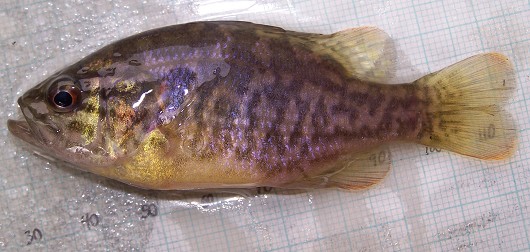Warmouth
-
Scientific NameLepomis gulosus
-
NativeNo
-
Identification
 Warmouth, captured in rotary screw trap on Sacramento River at Knight's Landing on 12/16/2009. Length approximately 9 cm (3.5 inches). Photo by Kasie Barnes, California Department of Fish and Game. Note: Measurement scale is in millimetres.
Warmouth, captured in rotary screw trap on Sacramento River at Knight's Landing on 12/16/2009. Length approximately 9 cm (3.5 inches). Photo by Kasie Barnes, California Department of Fish and Game. Note: Measurement scale is in millimetres.- Very stout and slightly deep body
- Rounded pectoral fins
- Larger terminal mouth has maxillae that extend past the front margin of the eye
- Short stiff opercular flaps
- 9-11 dorsal, 9-10 anal, 5 pelvic, and 12-14 pectoral fin rays
- 10-11 dorsal, 3 anal, and 1 pelvic spine(s)
- 38-45 scales along the lateral line
- Brown with an iridescent green to purple tinge on the scales, dusky belly, 3-5 distinct lines radiating from the eye, 4-6 dark brown bars radiating across the cheek, and sometimes faint vertical bars on the sides
- Breeding males have bright red eyes and yellow bellies
-
Life History
Warmouth prefer warm, turbid, muddy-bottomed sloughs and backwaters with abundant vegetation or other cover, but are occasionally also found in reservoirs. Limited data puts their temperature tolerances around 22-28°C and their dissolved oxygen tolerances under 4 mg/L in warm water. In general Warmouth avoid salinities over 1-4 ppt, but can survive in areas up to 17 ppt. They are opportunistic predators that will hide in vegetation and quickly ambush their prey. Warmouth less than 5 cm TL feed mostly on small crustaceans but begin feeding on more insect larvae and snails as they grow. By the time Warmouth reach 10-13 cm TL aquatic insects will make up the majority of their diet, only to be replaced by fish and crayfish in individuals 13 cm and larger.
Warmouth reach maturity in their second or third summer when they reach 7-10 cm TL. Spawning occurs in late spring and early summer, when temperatures reach 21°C, and begins with males building nests near dense cover in water 0.5-1.5m deep. When a female is ready to spawn she will descend toward the nests of a groups of males who will begin courting immediately. Once a male is selected the pair will return to his nest for a mating ritual where the female turns on her side to release eggs while the male remains upright but positions himself perpendicular to the female to release his sperm. Each female can lay 4,500-63,000 eggs per season. In their native range Warmouth reach 3-9 cm TL in their first year and 13-21 cm TL in their fifth. Individuals over 28 cm TL are rare. Most live to between 6 and 8 years.
-
Links to Other ResearchN / A
